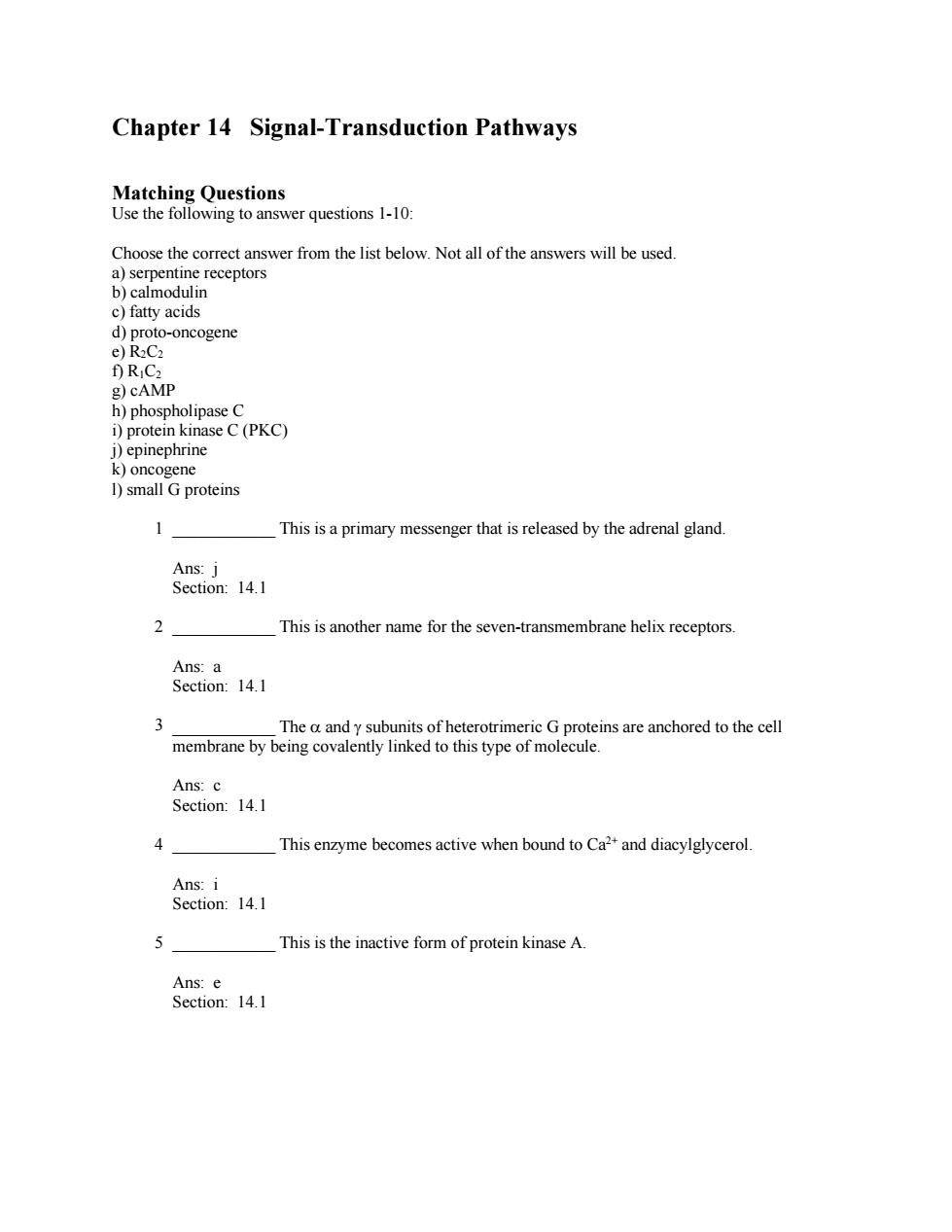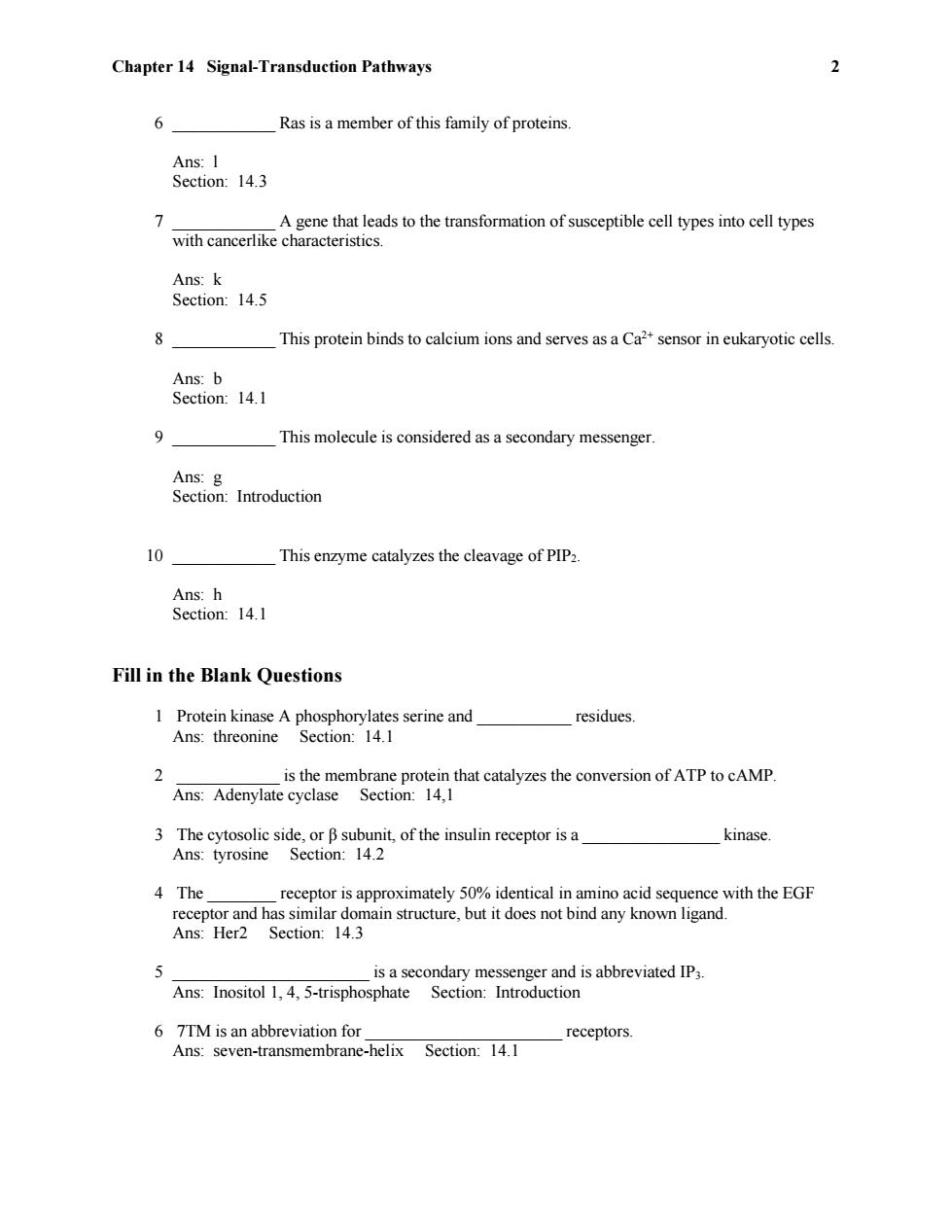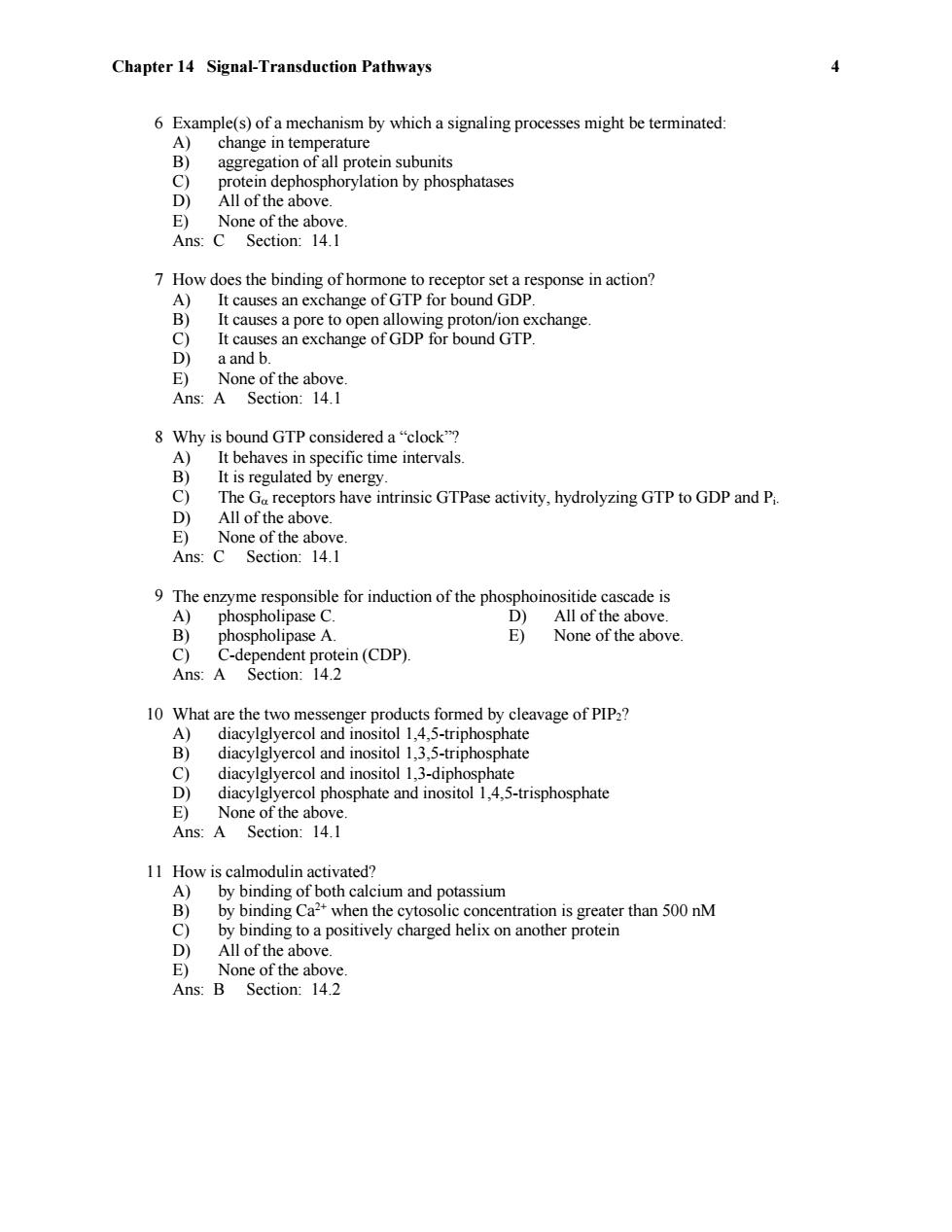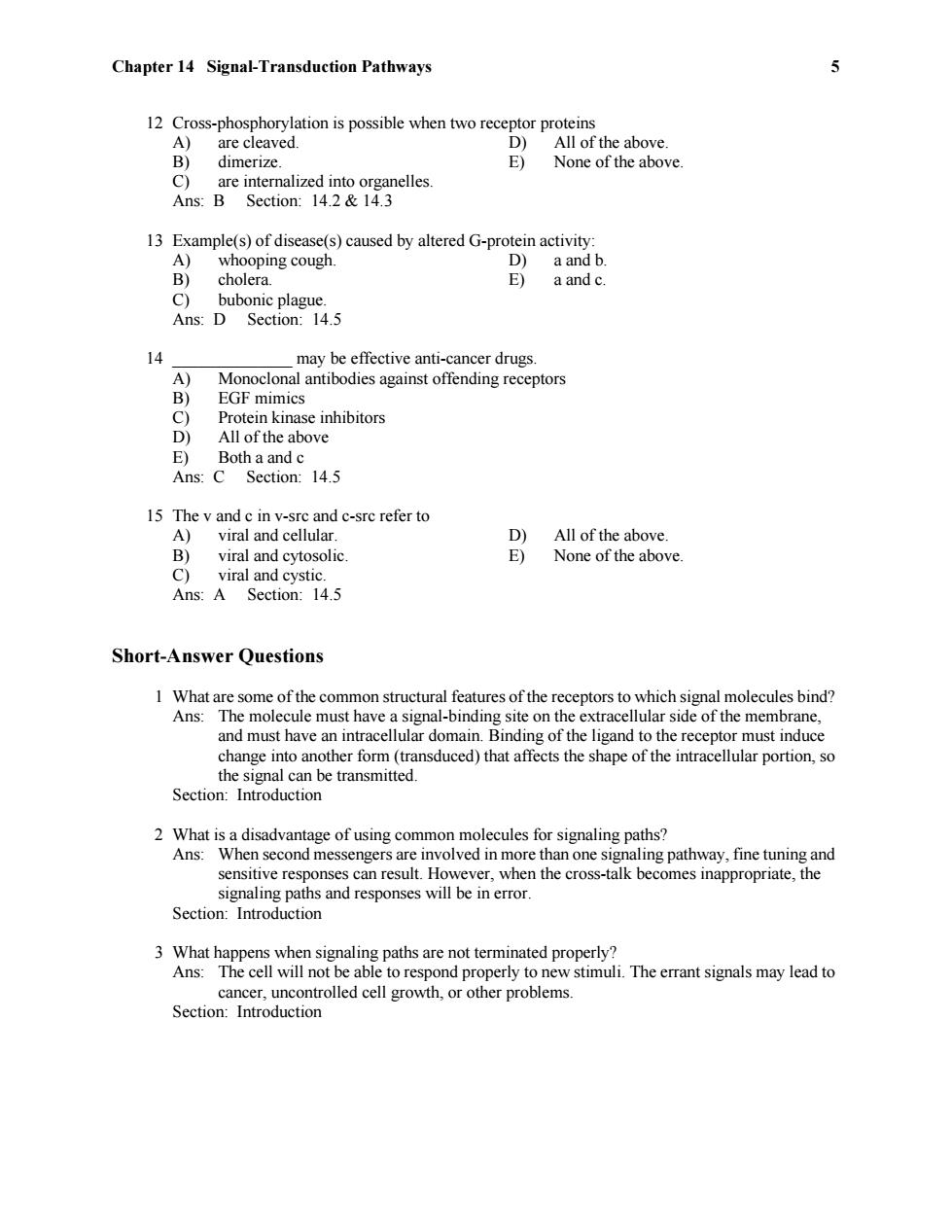
Chapter 14 Signal-Transduction Pathways Matching Questions Use the following to answer questions 1-10: Choose the correct answer from the list below.Not all of the answers will be used a)serpentine receptors b)calmodulin c)fatty acids d)proto-oncogene e)R2C2 f)RC2 g)cAMP h)phospholipase C i)protein kinase C(PKC) j)epinephrine k)oncogene 1)small G proteins 1 This is a primary messenger that is released by the adrenal gland. Ans:j Section:14.1 2 This is another name for the seven-transmembrane helix receptors Ans:a Section:14.1 The a and y subunits of heterotrimeric G proteins are anchored to the cell membrane by being covalently linked to this type of molecule. Ans:c Section:14.1 This enzyme becomes active when bound to Ca2+and diacylglycerol Ans:i Section:14.1 5 This is the inactive form of protein kinase A. Ans:e Section:14.1
Chapter 14 Signal-Transduction Pathways Matching Questions Use the following to answer questions 1-10: Choose the correct answer from the list below. Not all of the answers will be used. a) serpentine receptors b) calmodulin c) fatty acids d) proto-oncogene e) R2C2 f) R1C2 g) cAMP h) phospholipase C i) protein kinase C (PKC) j) epinephrine k) oncogene l) small G proteins 1 ____________ This is a primary messenger that is released by the adrenal gland. Ans: j Section: 14.1 2 ____________ This is another name for the seven-transmembrane helix receptors. Ans: a Section: 14.1 3 ____________ The and subunits of heterotrimeric G proteins are anchored to the cell membrane by being covalently linked to this type of molecule. Ans: c Section: 14.1 4 ____________ This enzyme becomes active when bound to Ca 2+ and diacylglycerol. Ans: i Section: 14.1 5 ____________ This is the inactive form of protein kinase A. Ans: e Section: 14.1

Chapter 14 Signal-Transduction Pathways 2 6 Ras is a member of this family of proteins. Ans:I Section:14.3 7 A gene that leads to the transformation of susceptible cell types into cell types with cancerlike characteristics. Ans:k Section:14.5 8 This protein binds to calcium ions and serves as a Ca2+sensor in eukaryotic cells. Ans:b Section:14.1 9 This molecule is considered as a secondary messenger. Ans:g Section:Introduction 10 This enzyme catalyzes the cleavage of PIP2. Ans:h Section:14.1 Fill in the Blank Questions 1 Protein kinase A phosphorylates serine and residues. Ans:threonine Section:14.1 2 is the membrane protein that catalyzes the conversion of ATP to cAMP. Ans:Adenylate cyclase Section:14,1 3 The cytosolic side,or B subunit,of the insulin receptor is a kinase. Ans:tyrosine Section:14.2 4 The receptor is approximately 50%identical in amino acid sequence with the EGF receptor and has similar domain structure,but it does not bind any known ligand. Ans:Her2 Section:14.3 is a secondary messenger and is abbreviated IP3. Ans:Inositol 1,4,5-trisphosphate Section:Introduction 6 7TM is an abbreviation for receptors. Ans:seven-transmembrane-helix Section:14.1
Chapter 14 Signal-Transduction Pathways 2 6 ____________ Ras is a member of this family of proteins. Ans: l Section: 14.3 7 ____________ A gene that leads to the transformation of susceptible cell types into cell types with cancerlike characteristics. Ans: k Section: 14.5 8 ____________ This protein binds to calcium ions and serves as a Ca 2+ sensor in eukaryotic cells. Ans: b Section: 14.1 9 ____________ This molecule is considered as a secondary messenger. Ans: g Section: Introduction 10 ____________ This enzyme catalyzes the cleavage of PIP2. Ans: h Section: 14.1 Fill in the Blank Questions 1 Protein kinase A phosphorylates serine and ___________ residues. Ans: threonine Section: 14.1 2 ____________ is the membrane protein that catalyzes the conversion of ATP to cAMP. Ans: Adenylate cyclase Section: 14,1 3 The cytosolic side, or β subunit, of the insulin receptor is a ________________ kinase. Ans: tyrosine Section: 14.2 4 The ________ receptor is approximately 50% identical in amino acid sequence with the EGF receptor and has similar domain structure, but it does not bind any known ligand. Ans: Her2 Section: 14.3 5 _______________________ is a secondary messenger and is abbreviated IP3. Ans: Inositol 1, 4, 5-trisphosphate Section: Introduction 6 7TM is an abbreviation for _______________________ receptors. Ans: seven-transmembrane-helix Section: 14.1

Chapter 14 Signal-Transduction Pathways 3 7 binds to B-andrenergic receptors. Ans:Epinephrine,adrenaline Section:14.1 8 The binding of IP3 to the IP,receptor results in the release of from the endoplasmic reticulum. Ans:calcium ion Section:14.1 9 The catalytically active form of the insulin receptor is a result of phosphorylation of specific residues in the activation loop. Ans:tyrosine Section:14.2 10 EGR signaling is terminated by the action of phosphatases and the hydrolysis of by Ras. Ans:GTP Section:14.3 Multiple Choice Questions 1 Most signal molecules A) easily diffuse through the membrane and bind to a receptor in the cytoplasm. B) bind to membrane receptors and transmit information across a membrane without traversing the membrane. C) carry out functions in the nucleus after binding to a receptor in the cell membrane. D) a and c. E) a,b,and c. Ans:B Section:Introduction 2 Examples of second messengers include: A) cAMP D) a and b. B) calcium ion. E) a.b.and c. C) diacyl glycerol Ans:E Section:Introduction 3 Advantages of second messengers include: A) the signal can be amplified by making many second messengers. B) second messengers can freely diffuse to other sites within the cell. c) a few common second messengers can be used in multiple signaling pathways. D) All of the above. E)None of the above. Ans:D Section:Introduction 4 Which of the following amino acids can be phosphorylated? A)tyr,ser,thr D)his,ser,phe B)tyr,ser,trp E)tyr,met,trp C)ser,thr,asn Ans:A Section:14.1 5 Which form of the guanyl nucleotide is bound in the unactivated state? A)GTP B)GDP C)GMP D)dGTP E)None of the above. Ans:B Section:14.1
Chapter 14 Signal-Transduction Pathways 3 7 _______________________ binds to β-andrenergic receptors. Ans: Epinephrine, adrenaline Section: 14.1 8 The binding of IP3 to the IP3 receptor results in the release of __________ from the endoplasmic reticulum. Ans: calcium ion Section: 14.1 9 The catalytically active form of the insulin receptor is a result of phosphorylation of specific ____________ residues in the activation loop. Ans: tyrosine Section: 14.2 10 EGR signaling is terminated by the action of phosphatases and the hydrolysis of _____________ by Ras. Ans: GTP Section: 14.3 Multiple Choice Questions 1 Most signal molecules A) easily diffuse through the membrane and bind to a receptor in the cytoplasm. B) bind to membrane receptors and transmit information across a membrane without traversing the membrane. C) carry out functions in the nucleus after binding to a receptor in the cell membrane. D) a and c. E) a, b, and c. Ans: B Section: Introduction 2 Examples of second messengers include: A) cAMP. D) a and b. B) calcium ion. E) a, b, and c. C) diacyl glycerol. Ans: E Section: Introduction 3 Advantages of second messengers include: A) the signal can be amplified by making many second messengers. B) second messengers can freely diffuse to other sites within the cell. C) a few common second messengers can be used in multiple signaling pathways. D) All of the above. E) None of the above. Ans: D Section: Introduction 4 Which of the following amino acids can be phosphorylated? A) tyr, ser, thr D) his, ser, phe B) tyr, ser, trp E) tyr, met, trp C) ser, thr, asn Ans: A Section: 14.1 5 Which form of the guanyl nucleotide is bound in the unactivated state? A) GTP B) GDP C) GMP D) dGTP E) None of the above. Ans: B Section: 14.1

Chapter 14 Signal-Transduction Pathways 4 6 Example(s)of a mechanism by which a signaling processes might be terminated: A) change in temperature B) aggregation of all protein subunits c) protein dephosphorylation by phosphatases D All of the above. E) None of the above Ans:C Section:14.1 7 How does the binding of hormone to receptor set a response in action? A)It causes an exchange of GTP for bound GDP. B) It causes a pore to open allowing proton/ion exchange. C) It causes an exchange of GDP for bound GTP. D) a and b. E)None of the above. Ans:A Section:14.1 8 Why is bound GTP considered a"clock"? A)It behaves in specific time intervals. B) It is regulated by energy. C) The Ga receptors have intrinsic GTPase activity,hydrolyzing GTP to GDP and Pi. D) All of the above. E) None of the above. Ans:C Section:14.1 9 The enzyme responsible for induction of the phosphoinositide cascade is A) phospholipase C. D)All of the above. B) phospholipase A E) None of the above. C) C-dependent protein(CDP) Ans:A Section:14.2 10 What are the two messenger products formed by cleavage of PIP2? A) diacylglyercol and inositol 1,4,5-triphosphate B)diacylglyercol and inositol 1,3.5-triphosphate C) diacylglyercol and inositol 1,3-diphosphate D) diacylglyercol phosphate and inositol 1,4,5-trisphosphate E)None of the above. Ans:A Section:14.1 11 How is calmodulin activated? A)by binding of both calcium and potassium B)by binding Ca2+when the cytosolic concentration is greater than 500 nM C)by binding to a positively charged helix on another protein D)All of the above E)None of the above. Ans:B Section:14.2
Chapter 14 Signal-Transduction Pathways 4 6 Example(s) of a mechanism by which a signaling processes might be terminated: A) change in temperature B) aggregation of all protein subunits C) protein dephosphorylation by phosphatases D) All of the above. E) None of the above. Ans: C Section: 14.1 7 How does the binding of hormone to receptor set a response in action? A) It causes an exchange of GTP for bound GDP. B) It causes a pore to open allowing proton/ion exchange. C) It causes an exchange of GDP for bound GTP. D) a and b. E) None of the above. Ans: A Section: 14.1 8 Why is bound GTP considered a “clock”? A) It behaves in specific time intervals. B) It is regulated by energy. C) The G receptors have intrinsic GTPase activity, hydrolyzing GTP to GDP and Pi. D) All of the above. E) None of the above. Ans: C Section: 14.1 9 The enzyme responsible for induction of the phosphoinositide cascade is A) phospholipase C. D) All of the above. B) phospholipase A. E) None of the above. C) C-dependent protein (CDP). Ans: A Section: 14.2 10 What are the two messenger products formed by cleavage of PIP2? A) diacylglyercol and inositol 1,4,5-triphosphate B) diacylglyercol and inositol 1,3,5-triphosphate C) diacylglyercol and inositol 1,3-diphosphate D) diacylglyercol phosphate and inositol 1,4,5-trisphosphate E) None of the above. Ans: A Section: 14.1 11 How is calmodulin activated? A) by binding of both calcium and potassium B) by binding Ca 2+ when the cytosolic concentration is greater than 500 nM C) by binding to a positively charged helix on another protein D) All of the above. E) None of the above. Ans: B Section: 14.2

Chapter 14 Signal-Transduction Pathways 12 Cross-phosphorylation is possible when two receptor proteins A) are cleaved. D) All of the above. B) dimerize. E) None of the above. c) are internalized into organelles. Ans:B Section:14.2 &14.3 13 Example(s)of disease(s)caused by altered G-protein activity: A) whooping cough. D) a and b. B) cholera. E) a and c. C) bubonic plague. Ans:D Section:14.5 14 may be effective anti-cancer drugs. A) Monoclonal antibodies against offending receptors B) EGF mimics C) Protein kinase inhibitors D) All of the above E) Both a and c Ans:C Section:14.5 15 The v and c in v-src and c-src refer to A) viral and cellular. D) All of the above. B) viral and cytosolic E) None of the above. C) viral and cystic. Ans:A Section:14.5 Short-Answer Questions 1 What are some of the common structural features of the receptors to which signal molecules bind? Ans:The molecule must have a signal-binding site on the extracellular side of the membrane, and must have an intracellular domain.Binding of the ligand to the receptor must induce change into another form(transduced)that affects the shape of the intracellular portion,so the signal can be transmitted. Section:Introduction 2 What is a disadvantage of using common molecules for signaling paths? Ans:When second messengers are involved in more than one signaling pathway,fine tuning and sensitive responses can result.However,when the cross-talk becomes inappropriate,the signaling paths and responses will be in error. Section:Introduction 3 What happens when signaling paths are not terminated properly? Ans:The cell will not be able to respond properly to new stimuli.The errant signals may lead to cancer,uncontrolled cell growth,or other problems. Section:Introduction
Chapter 14 Signal-Transduction Pathways 5 12 Cross-phosphorylation is possible when two receptor proteins A) are cleaved. D) All of the above. B) dimerize. E) None of the above. C) are internalized into organelles. Ans: B Section: 14.2 & 14.3 13 Example(s) of disease(s) caused by altered G-protein activity: A) whooping cough. D) a and b. B) cholera. E) a and c. C) bubonic plague. Ans: D Section: 14.5 14 ______________ may be effective anti-cancer drugs. A) Monoclonal antibodies against offending receptors B) EGF mimics C) Protein kinase inhibitors D) All of the above E) Both a and c Ans: C Section: 14.5 15 The v and c in v-src and c-src refer to A) viral and cellular. D) All of the above. B) viral and cytosolic. E) None of the above. C) viral and cystic. Ans: A Section: 14.5 Short-Answer Questions 1 What are some of the common structural features of the receptors to which signal molecules bind? Ans: The molecule must have a signal-binding site on the extracellular side of the membrane, and must have an intracellular domain. Binding of the ligand to the receptor must induce change into another form (transduced) that affects the shape of the intracellular portion, so the signal can be transmitted. Section: Introduction 2 What is a disadvantage of using common molecules for signaling paths? Ans: When second messengers are involved in more than one signaling pathway, fine tuning and sensitive responses can result. However, when the cross-talk becomes inappropriate, the signaling paths and responses will be in error. Section: Introduction 3 What happens when signaling paths are not terminated properly? Ans: The cell will not be able to respond properly to new stimuli. The errant signals may lead to cancer, uncontrolled cell growth, or other problems. Section: Introduction